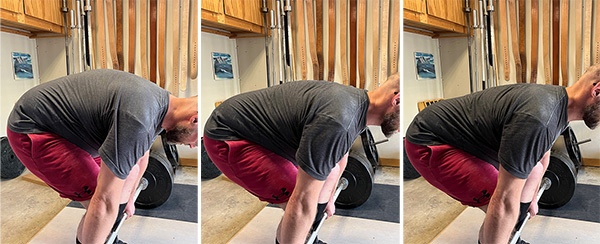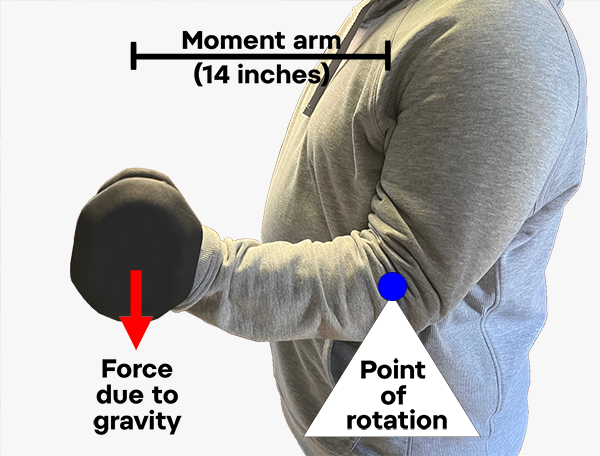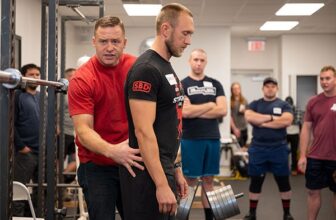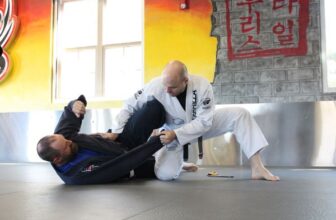
[adinserter block=”2″]
Each lift has technique elements that must be correct. Correctly following the five steps to a correct deadlift will produce a perfect deadlift set up every time, but mistakes can happen during and after the set up. Focusing on the critical technique elements will allow a lifter and coach to see the big picture and troubleshoot problems to find the root causes in the most effective way. The critical elements are back extension, mid-foot balance, bar path, and leg contact. Some aspects, like grip and eye gaze, must be correct to support the critical aspects, but are not in themselves critical.
Lumbar (Low-Back) Extension
Rigid extension of the back – specifically the lumbar – is critical. However, it is not immediately punished. Mistakes in the other three elements will always produce a poorer position. By contrast, if the lumbar rounds, the lifter is actually put in a mechanically better position off the ground because he effectively has longer arms. It can be tempting ignore rounding and keep adding weight to the bar. This temptation is understandable, but misguided.
First, the lumbar must be straightened at some point. A correct deadlift will do this at the start. A pull starting with a rounded lumbar will have to be straightened at the top. This may not be possible at heavy weights. Second, letting the lumbar round is not correctly stressing the muscles responsible for keeping it flat. Therefore, those muscles are not getting the same training effect as they do in a correct deadlift.
Finally, rounding the back under a load can cause injury. I have never observed a lifter hurt his back pulling rounded despite hearing that it happens frequently at public gyms. I have, however, seen lifters get hurt going from a flat lumbar to a rounded lumbar in the middle of the lift. The most common reason for this is jerking the bar off the ground or letting the bar get forward of the mid-foot. The pull must be initiated with a constant increase in force until the weight starts moving off the ground – smoothly, not with a sudden jerk.
This is one reason we teach our lifters to “push the floor away from the bar with the feet” instead of “pulling” the bar. Jerking or yanking the bar off the ground will produce a spike in stress on the low back. If that stress is higher than the strength the lumbar can hold in extension, it will round. Think about “squeezing” the bar up or pulling the bar “softly” off the ground. Even if all of this is done correctly, the lifter still has to set up with a flat lumbar prior to breaking the plates off the ground. Fortunately, there are a few simple methods to extend the lumbar during the set up.
Start the 5-step set up for the deadlift. During step 4, you will pick your chest up to extend your back. This will be sufficient most of the time, but some lifters will drop their butts while lifting their chests. Thinking “butt stays” can help, but doesn’t always solve the problem especially if the lifter has poor muscular control of his back. In this case, a teaching movement can help (Figure 1). Get set up, then when the time comes to “pick your chest up,” don’t. Instead, round your back. Then think “Un-round my back.” Do this a few times until you get the feeling right.

Figure 1. Rounding the back, then flattening (extending) the back.
This movement can give lifters with poor body control the sensation of what needs to happen. Thereafter, do this process only once when you set up. “Big breath. Round. Un-round. Push the floor away.” An added benefit to this cue of “un-round the back” is that your hips will tend not to move.
Finally, a weak grip will produce a rounded back. The back won’t pull what the hands can’t hold. Get chalk. Use a hook grip, mixed grip, or straps when needed. Don’t artificially limit your deadlift because of your grip.
Leg Contact, Mid-foot Balance, and Bar Path
Leg contact, mid-foot balance, and bar path are closely related. The bar must be in contact with the legs, because it produces the best position for the lifter. The combined center of mass of the lifter and barbell should always be over the top of the middle of the foot – halfway between the toe and heel. Finally, the bar should travel in a vertical line up and down. Any deviation from these three elements will produce inefficiency in the lift, which will have to be corrected on the way up if the lift is to be completed. A one-rep-max deadlift is an unforgiving lift: it cannot be completed inefficiently.
The fundamental way humans interact with their environment is the Moment Model of Skeletal Movement. The human body is made up of bones which act as rigid members (force transmitters) and the muscles (force generators) which pull on the bones. Consider a dumbbell biceps curl: the forearm pivots about the elbow which is the point of rotation, the dumbbell sits at the end of the forearm in the hand, and the “biceps” pull on the bone of the forearm at a distance from the joint – a third-class lever. This produces rotation of the forearm about the elbow joint.
The biceps only act on the dumbbell through the interactions with the forearm and elbow. The distance between the point of rotation (elbow) and the point of force application by the biceps is called a “moment arm” when measured at ninety degrees to the direction of force application. You can think of the “moment force” as the leverage along the horizontal line between the elbow and the dumbbell when gravity is the only force being opposed.

Figure 3. Biceps curl illustrating the moment arm between the load and elbow.
The moment arms in the deadlift are much more complex, since all of the levers in the body are involved. Still, mechanical work in the deadlift is only done when force is applied upward. Gravity is the only external force acting on the barbell, and gravity only causes force downward. Force should, therefore, only be applied to the barbell upward. Movement of the bar in any direction other than up represents inefficiency, illustrated by the unnecessary moment arm between the bar and mid-foot. Removing this inefficiency would allow the lifter to deadlift a heavier weight.
A vertical bar path over the mid-foot is possible without leg contact, but undesirable. Muscle mass that could have been involved has been removed. Sometimes lifters will accidentally stiff-leg deadlift with an artificially shortened moment arm between the knee and bar. This means the knee musculature cannot contribute to the movement as much. A way to think of this is that an effective lift requires an optimization of the necessary moment arms about the joints. In the case of the deadlift, this means that the bar is touching the legs at all times, the bar stays mid-foot, and travels in a vertical line at all times.
The most common leg contact error is when the bar swings out in front of the mid-foot as soon as the bar comes off the ground. This usually happens because the balance is forward of the mid-foot. To avoid this, rock back off your toes to balance over mid-foot before you pull. The bar can also swing away at any point in the deadlift if you’re not actively pulling the bar back into your legs. This is what the lats are responsible for – extending the shoulder and keeping the bar back over the mid-foot. Think about driving the bar into your legs using the hands. Another useful cue is to visualize “bending the bar around the legs.”
Another common issue with mid-foot balance is dropping the butt during set up or keeping the back too upright on the way down. Putting the bar down with too upright a back angle will push the knees forward causing the bar to ride the thighs, go forward, and land on the ground forward of the mid-foot in the wrong starting position. Additionally, dropping the butt during an otherwise correct set up will push the knees forward. This changes the shin angle and pushes the middle of the shin forward which shoves the bar forward of the mid-foot (Figure 3). If the knees are forward of the elbow pits, the shins are in the way, and the bar travels forward instead of vertically. If the knees are behind the elbow pits, the butt is too high and the shins are probably not in contact with the bar. Make sure the knees mate to the elbow pits every single rep.

Figure 3. Left to right, the knees mated to the elbow pits, the knees forward, the knees behind.
The bar will maintain a vertical path
if this is done correctly unless
the hips extend early or late. Late hip extension is a stiff-legged
deadlift. Early hip extension is what happens when you “pull” the
bar instead of push the floor – it will travel forward of
the mid-foot and around the unextended
knees. A one-rep-max deadlift
failed this way may have been successful if the knees had extended at
the correct time, and any successful 1RM deadlift was not pulled this
way.
In summary, a
correct deadlift will produce an immediate change in back angle off
the ground, but also knee extension. Off the ground, the knees will
travel backward, and the shins will become more vertical, getting out
of the way of the vertical bar path. Incorrectly pulling by leaving
the knees forward will force the bar to ride the shins forward of the
mid-foot. Thinking about pushing the floor away with the feet instead
of focusing on pulling the bar with the hands can help produce
correct knee extension.
It might seem counter-intuitive, but
none of these four critical technique elements will be obviously
wrong to you at heavy weights when you’re in the middle of the lift
– even if you fail the lift. Using video feedback or a coach will
be important in analyzing errors and fixing them. Correctly executing
these four critical elements will produce the best deadlift and allow
your lifter to get strong quickly and safely.
Discuss in Forums
[adinserter block=”2″]
Credit : Source Post






